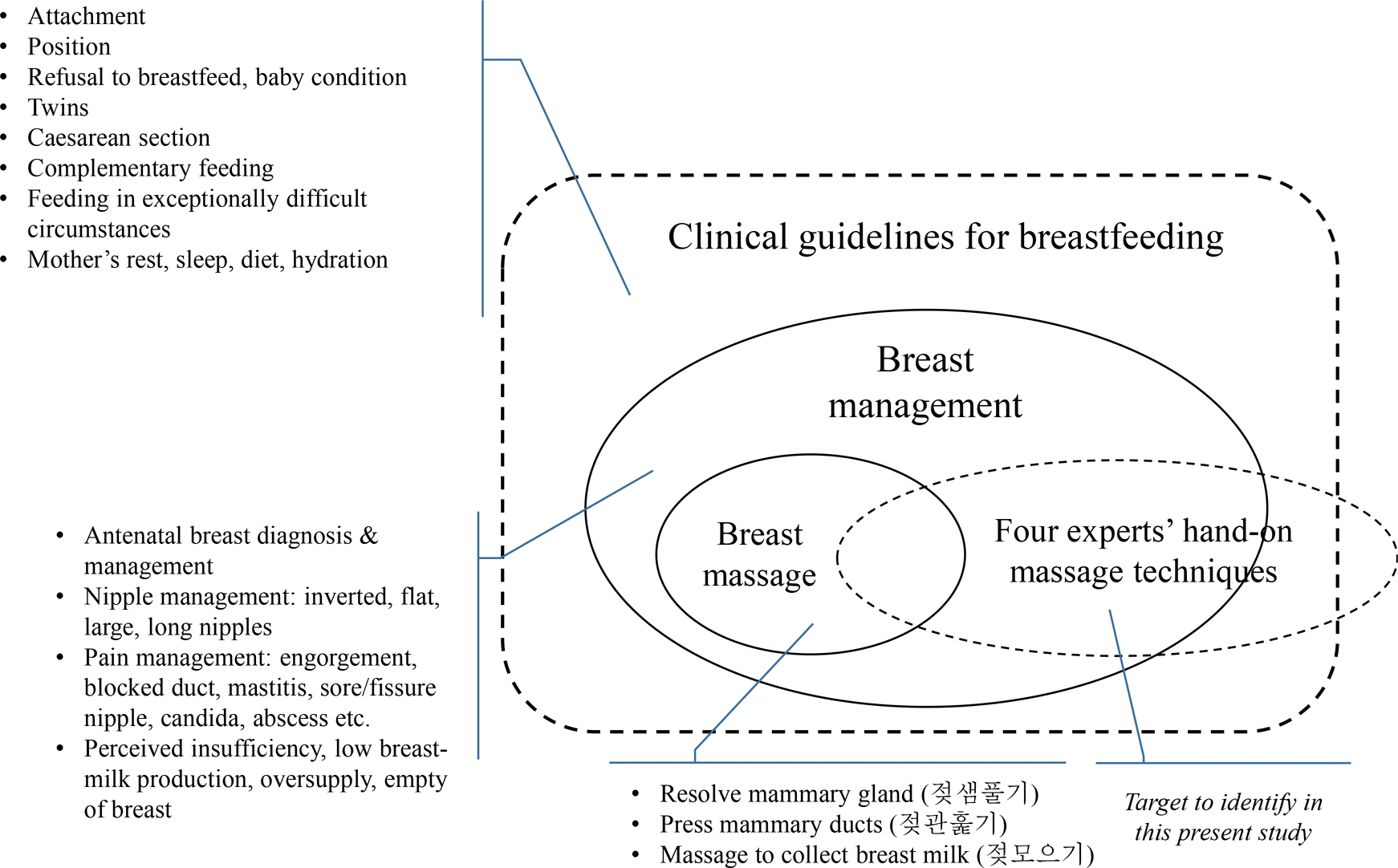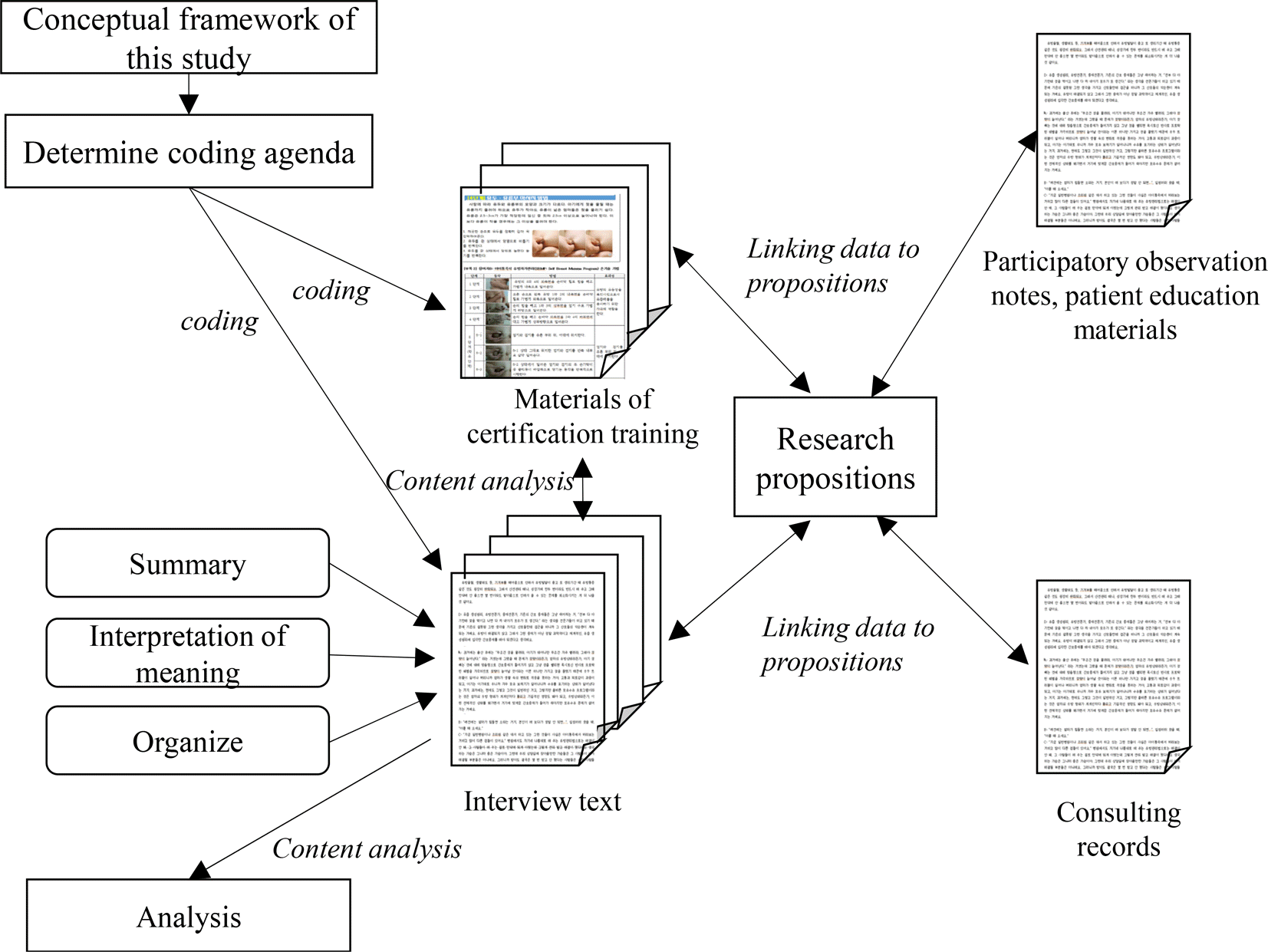Abstract
Purpose
The aim of this study was to understand the hand-on breast massage techniques used by well-known experts in breastfeeding clinics.
Methods
A qualitative multiple-case design was applied that involved a feasibility test. Four experts sampling qualitative data collected by observing participants and in individual interviews were analyzed by content analysis, linking data to the propositions, and cross-case pattern matching. This study explored differences within and between cases, and the possibilities of replicating findings across cases. Thirty-nine postpartum women participated voluntarily in the feasibility test, which investigated the usability of four massage techniques.
Results
The four techniques showed considerable similarities in terms of the application of stimulation to the breast base and increased flexibility of the wired flexible body, which was the core mechanism underlying the techniques. The breast management strategies were consistent with existing practice guidelines with the exception of using cold cabbage to control engorgement pain. There was insufficient scientific evidence for supporting the massage techniques used by the experts. All of the techniques showed 100% education completeness, but application rates were higher for self-control-oriented techniques.
REFERENCES
1. Park EY, Cho SJ, Lee K. Current understanding and practices of breast feeding by mothers. Korean Journal of Pediatrics. 2005; 48(11):1162–1165.
2. Kim HR. Breastfeeding trends, affecting factors and policy options for breastfeeding promotion in Korea. Health Welfare Policy Forum. 2013; 201(7):49–60.
3. Blyth R, Creedy DK, Dennis CL, Moyle W, Pratt J, De Vries SM. Effect of maternal confidence on breastfeeding duration: An application of breastfeeding self-efficacy theory. Birth. 2002; 29(4):278–284.

4. Sriraman NK, Kellams A. Breastfeeding: What are the barriers? why women struggle to achieve their goals. Journal of Women's Health. 2016; 25(7):714–722.

5. Kim JK, Choi HM, Ryu EJ. Postnatal breastfeeding knowledge, techniques and rates of first-time mothers depending on a prenatal breastfeeding education method. The Journal of Korean Academic Society of Nursing Education. 2011; 17(1):90–99.

6. Lewallen LP, Dick MJ, Flowers J, Powell W, Zickefoose KT, Wall YG, et al. Breastfeeding support and early cessation. Journal of Obstetric, Gynecologic & Neonatal Nursing. 2006; 35(2):166–172.

7. Kent JC, Prime DK, Garbin CP. Principles for maintaining or increasing breast milk production. Journal of Obstetric, Gynecologic & Neonatal Nursing. 2012; 41(1):114–121.

8. World Health Organization. Breastfeeding guidelines for successful breastfeeding. UNICEF Korea Committee, trannslator. Seoul: UNICEF Korea Committee;2009. p. 306.
9. Korea Health Industry Development Institute. Breastfeeding education instruction: Public health center maternal and child health educator breastfeeding education instruction guideline [Internet]. Cheongju: Author;2002. [cited 2017 April 10]. Available from:. http://phicom.mw.go.kr:7008/community/user/ebook/002/01.mother's%20milk%20guide.pdf.
10. Rieko K. Integration of breastfeeding care by nurse-midwives in Japan [Internet]. Japan: Welcome to Child Research Net;2010. [cited 2017 April 04]. Available from:. http://www.childresearch.net/papers/parenting/2010_01.html.
11. Hossain MA, Haque MI, Siddiqui AB, Bari MI. Activities of lactation management centre of Rajshahi. Journal of Teachers Association. 2005; 18(2):89–92.

12. Itongkok. National itongkok counseling center [Internet]. Seoul: Author;2011. [cited 2017 April 04]. Available from:. http://www.itongkok.co.kr/icons/app/cms/front.php.
13. Mowu 119. Korea SMC breastfeeding institute [Internet]. Incheon: Author;2013. [cited 2017 April 04]. Available from:. http://www.mowu119.com/main/sub4_3.php.
14. Chiu JY, Gau ML, Kuo SY, Chang YH, Kuo SC, Tu HC. Effects of Gua-Sha therapy on breast engorgement: A randomized controlled trial. Journal of Nursing Research. 2010; 18(1):1–10.
15. Bolman M, Saju L, Oganesyan K, Kondrashova T, Witt AM. Recapturing the art of therapeutic breast massage during breastfeeding. Journal of Human Lactation. 2013; 29(3):328–331.

16. Ahn SH, Kim JH, Cho JS. Effects of breast massage on breast Pain, breast-milk sodium, and newborn suckling in early postpartum mothers. Journal of Korean Academy of Nursing. 2011; 41(4):451–459.

17. Song JA. A systematic review of breast care for postpartum mothers [dissertation]. Daejeon: Eulji University;2015. p. 103.
18. World Health Organization. Infant and young child feeding: Model chapter for textbooks for medical students and allied health professionals. Geneva: World Health Organization;2009. p. 112.
19. Jeon SY. Theme planning, self-development is competitive [Internet]. Seoul: Samsung Medical Center;2004. [cited 2017 January 01]. Available from:. http://www.smc.or.kr/mgzn/2004_0304/02.html.
20. Cho JS. National breastfeeding counseling center [Internet]. Seoul: Oketani Breastfeeding Counseling Center;2007. [cited 2017 April 04]. Available from:. http://oketani.co.kr/.
21. Mohrbacher N. Breastfeeding answers made simple: A guide for helping mother. New York, NY: Hale Publishing;2010. p. 795–798.
22. Holmes AV, McLeod AY, Bunik M. ABM clinical protocol #5: Peripartum breastfeeding management for the healthy mother and infant at term, revision 2013. Breastfeeding Medicine. 2013; 8(6):469–473.

23. Korean Nurses Association. Breastfeeding campaign [Internet]. Seoul: Korean Nurses Association;2016. [cited 2016 September 20]. Available from:. http://www.koreanurse.or.kr/leading_initiatives/breast_feeding_summary.php.
24. Kohlbacher O, Quinten S, Sturm M, Mayr BM, Huber CG. Structure-activity relationships in chromatography: Retention prediction of oligonucleotides with support vector regression. Angewandte Chemie International Edition. 2006; 45(42):7009–7012.

25. Krefting L. Rigor in qualitative research: The assessment of trustworthiness. The American Journal of Occupational Therapy. 1991; 45(3):214–222.

26. Hennink M, Hutter I, Bailey A. Qualitative research methods. London: SAGE publication Ltd;2011. p. 334.
27. Netsu Y. Breast management. Japan: Myung-ryun Bookstore;1993. p. 207.
28. Hong SM. Effect and obstacles of breastfeeding practices and continuance by breastfeeding clinic at a local public health center [master's thesis]. Seoul: Chung-Ang University;2010. p. 61.
29. Cho JS. Effects of Oketani's breast massage on the breast discomfort, breast milk pH of mother and the sucking speed of neonate [master's thesis]. Daejeon: Eulji University;2006. p. 65.
30. Arora S, Vatsa M, Dadhwal V. A comparison of cabbage leave vs. hot and cold compresses in the treatment of breast engorgement. Indian Journal of Community Medicine. 2008; 33(3):160–162.
Table 1.
Feasibility Test Results for Four Breast Massage Techniques




 PDF
PDF ePub
ePub Citation
Citation Print
Print





 XML Download
XML Download